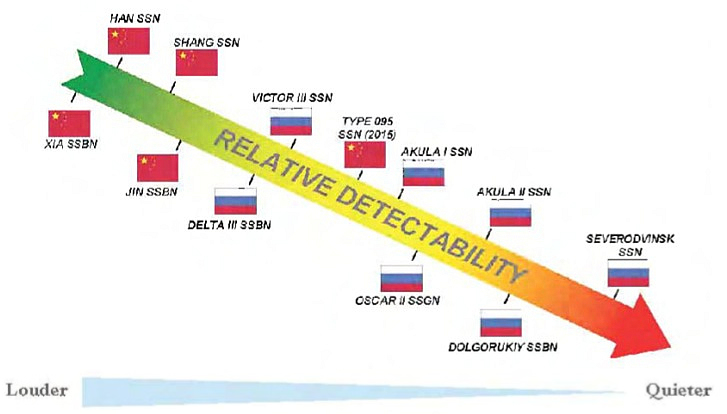| China’s Noisy Nuclear Submarines
中国新核潜艇噪音过大 Date:2013-10-26 Source:fas By:globalmil Viewed: |
By Hans M. Kristensen
作者:汉斯·克里斯滕森
China’s new Jin-class ballistic missile submarine is noisier than the Russian Delta III-class submarines built more than 30 years ago, according to a report produced by the U.S. Navy’s Office of Naval Intelligence (ONI).
依照美国海军情报办公室(ONI)公布的一份报告,中国新的晋级弹道导弹潜艇噪音超过30年以前俄国建造的“德尔塔” III级潜艇。
The report The People’s Liberation Army Navy: A Modern Navy With Chinese Characteristics, which was first posted on the FAS Secrecy News Blog and has since been removed from the ONI web site [but now back here; thanks Bruce], is to my knowledge the first official description made public of Chinese and Russian modern nuclear submarine noise levels.
中国海军报告:《中国特色的现代化海军》,自从被美国海军情报办公室网站删除后[但现在在这里;谢谢布鲁斯]被首先转载发表在FAS秘密新闻博客上,对我的理解这是第一份官方对中国和俄国目前核潜艇噪音水平的描述。
Force Level
The report shows that China now has two Jin SSBNs, one of which is based at Hainan Island with the South Sea Fleet, along with two Type 093 Shang-class nuclear-powered attack submarines (SSN). The Jin was first described at Hainan in February 2008 and the two Shangs in September 2008. The second Jin SSBN is based at Jianggezhuang with the North Sea Fleet alongside the old Xia-class SSBN and four Han-class SSNs.
力量水平
报告表明中国现在有二艘晋级弹道导弹核潜艇(SSBN),其中之一在南海舰队的海南岛基地,连同二艘093型商级核攻击潜水艇(SSN)一起部署。晋级最初在2008年2月海南被发现接着两艘商级在2008年9月。第二艘晋级SSBN在北海舰队的姜格庄基地与旧型号夏级SSBN和四艘汉级SSN一起部署。
The report confirms the existence of the Type 095, a third-generation SSN intended to follow the Type 093 Shang-class. Five Type 095s are expected from around 2015. The Type-95 is estimated to be noisier than the Russian Akula I SSN built 20 years ago.
报告证实095型攻击核潜艇(SSN)的存在,第三代SSN意图去替代093型商级。五艘095型被期望从2015年左右部署。095型被估计比俄国在20年以前建造的阿库拉 I级SSN噪音更大。
Missile Range
The ONI report states that the JL-2 sea-launched ballistic missile on the Jin SSBNs has a range of ~4,000 nautical miles (~7,400 km) “is capable of reaching the continental United States from Chinese littorals.” Not quite, unless Chinese littorals extend well into the Sea of Japan. Since the continental United States does not include Alaska and Hawaii, a warhead from a 7,400-km range JL-2 would fall into the sea about 800 km from Seattle. A JL-2 carrying penetration aids in addition to a warhead would presumably have a shorter range.
导弹射程
ONI报告指出晋级SSBN上的巨浪-2(JL-2)潜射弹道导弹具有射程~4,000海里(~7,400公里)“能够从中国沿海到达美国大陆”。不完全是,除非中国沿海延长到日本海洋。因为美国大陆不包括安拉斯加州和夏威夷,来自7,400公里射程JL-2的一枚弹头会大约掉入距西雅图800公里的海中。JL-2导弹携带突防辅助工具,弹头的射程将会进一步缩短。
|
Julang-2 SLBM Range According to ONI |
 |
| Although the ONI report states that the Julang-2 can target the Continental United States, the range estimate it provides is insufficient to reach the lower 48 states or Hawaii.尽管依照ONI报告称JL-2能打击美国大陆,估计它提供的射程是不够到达美国本土或夏威夷。 |
.
Alaska would be in range if the JL-2 is launched from the very northern parts of Chinese waters, but Hawaii is out of range unless the missile is launched from a position close to South Korea or Japan. The U.S. Defense Department’s 2009 report to Congress on the Military Power of the People’s Republic of China also shows the range of the JL-2 to be insufficient to target the Continental United States or Hawaii from Chinese waters. The JL-2 instead appears to be a regional weapon with potential mission against Russia and India and U.S. bases in Guam and Japan.
如果JL-2从中国水域的最北部分发射,安拉斯加州会在射程中,但是夏威夷在射程外除非导弹从一个靠近韩国或日本位置发射。美国国防部在2009年提交给国会的中国军力报告评估中也认为JL-2的射程从中国水域不够打击美国大陆或夏威夷。JL-2反而似乎是对抗俄国、印度、美国在关岛和日本基地的潜在任务的一个地区性武器。
Patrol Levels
The report also states that Chinese submarine patrols have “more than tripled” over the past few years, when compared to the historical levels of the last two decades.
巡逻水平
报告也称与上个二十年历史水平相比,中国潜艇巡逻在过去几年以来“超过三倍”。
That sounds like a lot, but given that the entire Chinese submarine fleet in those two decades in average conducted fewer than three patrols per year combined, a trippling doesn’t amout to a whole lot for a submarine fleet of 63 submarines. According to data obtained from ONI under FOIA, the patrol number in 2008 was 12.
这听起来非常像,但是考虑到整个中国潜艇舰队在过去20年里每年出海巡逻的次数平均总共不超过3次,这与拥有63艘潜艇的中国潜艇部队来说是不相称的。在“情报自由法(FOIA)”下依照从ONI获得数据,巡逻数字在2008年是12次。
Since only the most capable of the Chinese attack submarines presumably conduct these patrols away from Chinese waters – and since China has yet to send one of its ballistic missile submarines on patrol – that could mean one or two patrols per year per submarine.
鉴于只有中国最有能力的攻击潜艇据推测执行这些远离中国水域的巡逻–而且中国还没派遣它的弹道导弹潜艇其中之一去巡逻–可能意味着每艘潜艇每年一次或二次巡逻。
Implications
The ONI report concludes that the Jin SSBN with the JL-2 SLBM gives the PLA Navy its first credible second-strike nuclear capability. The authors must mean in principle, because in a war such noisy submarines would presumably be highly vulnerabe to U.S. or Japanese anti-submarine warfare forces. (The noise level of China’s most modern diesel-electric submarines is another matter; ONI says some are comparable to Russian diesel-electric submarines).
启示
ONI报告得出结论晋级SSBN拥有JL-2 SLBM第一次赋予PLA海军可靠的第二次核打击能力。报告作者一定大体而言,因为在战争中如此嘈杂的潜艇据推测对美国或日本反潜战力量来讲是非常脆弱。(中国最大多数的现代化柴电潜艇噪音水平是另外的一个话题;ONI称一些可与俄国柴电潜艇相比较)。
That does raise an interesting question about the Chinese SSBN program: if Chinese leaders are so concerned about the vulnerability of their nuclear deterrent, why base a significant portion of it on a few noisy platforms and send them out to sea where they can be sunk by U.S. attack submarines in a war? And if Chinese planners know that the sea-based deterrent is much more vulnerable than its land-based deterrent, why do they waste money on the SSBN program?
有关中国SSBN计划确实提出一个有趣的问题:如果中国领导层如此关心他们脆弱的核力量,重要一部分建立在几个嘈杂平台上并且派遣它们出海,到它们在战争中能被美国攻击潜艇击沉的海域?而且如果中国计划者知道海-基威慑力量比它的陆基更脆弱,为什么造成他们在SSBN计划上浪费资金?
The answer is probably a combination of national prestige and scenarios involving India or Russia that have less capable anti-submarine forces.
答案或许是结合国家声望和对付包括印度或俄罗斯等那些拥有较少反潜能力的力量。
上一篇:Bluffer’s Guide: Fortress China[C] 下一篇:Estimated Nuclear Weapons Locations 2009
| The Booker dilemma: inside US Army transformation
“布克”困境:美国陆军转型内幕 |
| The decision to cancel the M10 Booker light tank is at the core of a reordering of US Army planning.... [2025-07-16] |
| Focus: A fragile balance in Asia, China has become leading military power in the
焦点:亚洲平衡脆弱,中国已成为该地区的主要军事力量 |
| However, China's rapid military growth in this area is tipping the balance in favor of regional power. ... [2024-08-27] |
| Small drones will soon lose combat advantage, French Army chief says
法国陆军总司令表示,小型无人机将很快失去战斗优势 |
| By Rudy Ruitenberg Thursday, Jun 20, 2024 作者:鲁迪瑞滕伯格 2024年6月20日星期四 French Army Chief of Staff Gen. Pierre Schill inspecting a Rapid Eagle anti-drone system at the Eurosatory defense show in Paris on June 19, 202... [2024-08-18] |
| What’s next for Ukraine’s incursion into Russia?
乌克兰入侵俄罗斯的下一步是什么? |
| Ukraine’s forces have surprised us all with its recent incursion into Russia’s Kursk Oblast since the operation to turn the tide of the war,... [2024-08-17] |

